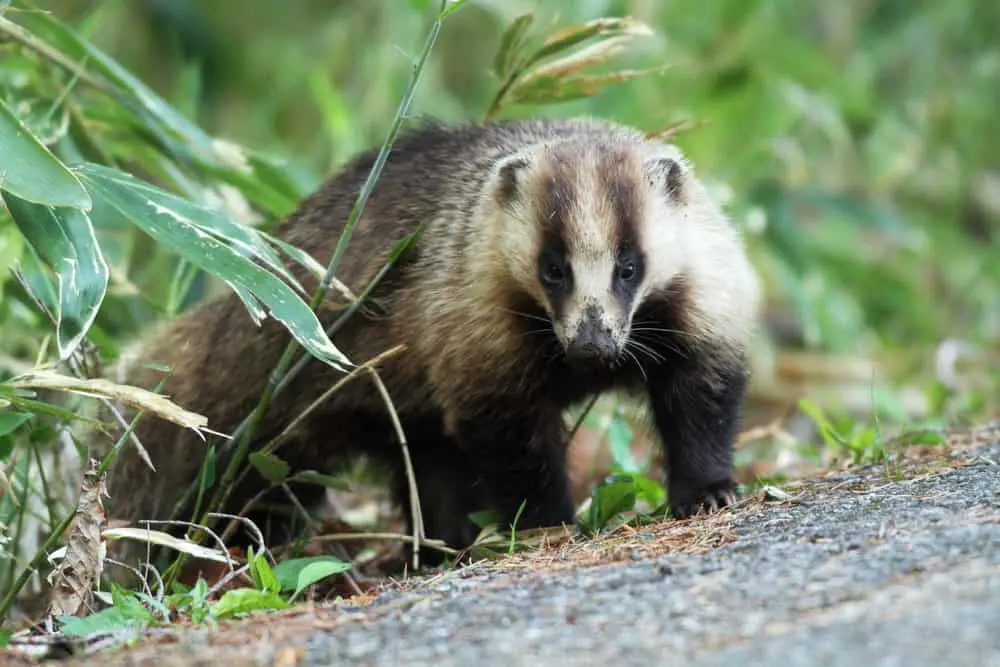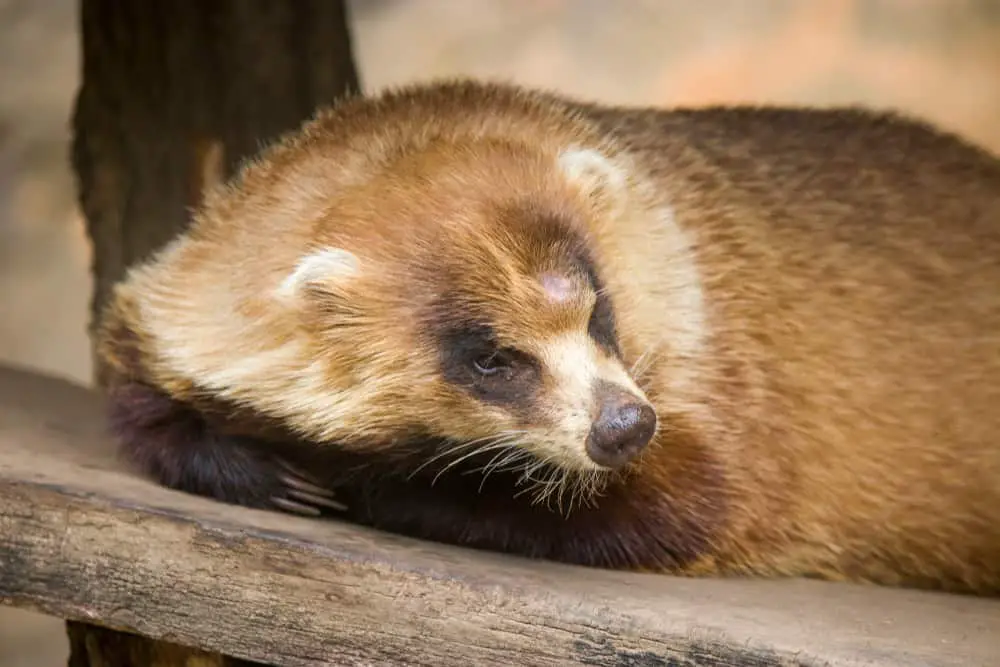The Japanese badger (Meles anakuma) is a species of mustelid endemic to Japan. It is the only extant member of its genus and is closely related to Eurasian badgers.
This mammal has been known to inhabit various areas, from mountain forests and grasslands in Hokkaido, Honshu, Shikoku, Kyushu and other islands. Its physical characteristics include black fur with white stripes along the sides of the face and neck as well as greyish-brown or reddish fur on the back and legs. Furthermore, they have long claws adapted for digging burrows which are used as shelters during harsh weather conditions.
The Japanese badger plays an important role in local ecosystems by preying on small rodents such as mice and voles while also consuming insects, amphibians, fruits and nuts when available. They are solitary animals but may form social groups within their own territory during breeding season.
Knowledge about this species’ behavior patterns will be essential in protecting them against human encroachment into their habitats.

Distribution And Habitat
The Japanese badger is a species of small-to-medium sized mustelid that inhabits the temperate regions of Japan.
It is found in deciduous and coniferous forest environments, as well as grassland habitats up to 3,000 meters above sea level.
The Japanese badger has adapted to living underground by constructing complex burrow structures with multiple entrances and chambers for various functions such as nesting, storage, and escape from predators.
Population dynamics of this species vary greatly depending on region due to human activity and environmental changes.
Studies have shown that in some areas where human presence is low, the population density can range from 5 – 10 individuals per square kilometer; however, in heavily populated urban or agricultural areas these numbers can drop significantly.
Conservation efforts are essential for maintaining healthy populations at sustainable levels throughout the native range of this species.
Physical Characteristics
The Japanese Badger is a small mammal native to Japan. It has short, dense fur with a coarse texture and its body size can range from 20-32 inches long.
The badger is usually greyish brown in color, with black stripes running along its back. Its head is broader than its neck, giving it an overall round shape. The tail of the Japanese Badger measures roughly 5-7 inches long and is primarily white in color.
Its limbs are relatively short compared to other badgers and their paws have five toes each that are equipped with sharp claws for digging purposes. This species also has large eyes which help them see better in low light conditions as they are mainly nocturnal hunters.
Diet And Feeding Habits
Japanese badgers primarily feed on small animals, such as rodents and amphibians. They also supplement their diet with fruits, roots, and other plant material. Their foraging patterns involve frequent traveling along established paths to different burrows in search of food.
Badger burrows are usually located near a water source, providing an optimal environment for them to inhabit. The structure consists of several tunnels that branch off from the main entrance. These tunnel systems often contain many chambers used by the badger for sleeping or storing food caches.
Badgers will typically use one primary den site throughout most of the year, though they may switch sites depending on availability of resources or disturbances caused by humans or predators.
Breeding And Reproduction
The foraging behavior of the Japanese badger is dominated by a combination of fossorial and cursorial activities that are mainly conducted at night.
The species has an omnivorous diet composed of fruits, small insects, rodents, carrion, worms, eggs, and roots.
During mating rituals in springtime, male badgers become very aggressive with one another as they compete to win over females.
Male Japanese badgers typically engage in physical combat to establish their dominance when competing for potential mates.
Mating usually takes place within burrows where a female generally gives birth to two or three cubs after around 60 days gestation period.
In order to protect her young from predators and other disturbances, the mother will remain inside the den until the cubs can fend off danger on their own.
Social Behavior
Japanese badgers are social animals and display complex group dynamics. They form stable groups of 3-4 individuals, with a single male and multiple females as the core members. These family units remain together in their home range for up to 16 months before disbanding or changing membership.
Social interactions within these groups involve vocalizations, scent marking, grooming and allogrooming behaviors that serve to maintain cohesion and allow for cooperative behavior between members.
Outside of the family unit, Japanese badgers interact more loosely with other non-related individuals. During peak summer months they may gather into larger aggregations formed by numerous intermingling family units, where they feed on communal resources such as nuts and fruit fallen from trees.
Although there is some evidence of aggressive displays during this period, it appears that dominance hierarchies do not exist among unrelated adult individuals in these gatherings.
In sum, Japanese badger society is characterized by relatively flexible but highly structured social dynamics which facilitate cooperation both within and outside of family units.
Interactions With Humans
Japanese badgers have had a long history of interactions with humans, and as such have been endowed with cultural significance in Japan. The species has been featured in Japanese art and literature for centuries, often playing the role of wise old sage or teacher.
Many cultural myths also surround the animal; one popular story tells how a kindly badger helped to save an entire village from destruction by using its strength to carry away unstable boulders threatening to collapse on homes.
The presence of Japanese badgers near human dwellings can lead to conflict due to raiding of vegetable gardens, though they are not considered major agricultural pests. Badgers that persistently raid crops are sometimes captured and relocated further away from inhabited areas.
In general, however, these animals tend to be viewed favorably by most people who encounter them.
Threats And Conservation
Pervasive pressure and perilous peril plague the plight of Japanese badgers. Climate change is pushing them out of their habitats while illegal hunting continues to threaten their population size.
A 4 point plan must be implemented in order to protect this species:
- Increase habitat protection through policy changes.
- Raise awareness among local communities about the importance of conservation efforts.
- Implement more robust enforcement against illegal hunting activities.
- Continue research into adaptation strategies for a changing climate environment.
Conservationists need to join forces in order to ensure that these measures are successful, as preserving the long-term future of the Japanese Badger depends on our collective action today.
With effective implementation, we can reduce current threats and work towards a sustainable future for all wildlife, including the beloved Japanese badger.

Interesting Facts
The Japanese badger (Meles anakuma) is a species of mustelid that inhabits the main islands of Japan. While this species has been threatened by habitat destruction and human exploitation, conservation efforts have also been implemented in recent years. As such, there are now several interesting facts about these animals worth noting.
For instance, Japanese badgers have become culturally significant symbols in Japanese culture. In particular, they represent courage and strength due to their boldness when it comes to defending against intruders or predators. Moreover, they often appear in folklore stories as creatures with magical powers. Furthermore, despite its small size, the Japanese badger can produce loud vocalizations like growls and bleats which give them even greater cultural symbolism within Japan.
Due to language barriers between English and Japanese cultures, some of the more intricate details regarding the cultural symbolism of the Japanese badger may be lost on those unfamiliar with the language; however, its unique attributes remain unchanged regardless of one’s understanding of it. From its physical characteristics to its behavioral traits, the Japanese badger offers plenty for researchers and admirers alike to marvel at.
Conclusion
The Japanese badger is a unique and fascinating animal found in Japan. It inhabits various habitats from woodlands to grassy areas and has adapted well to urban environments as well.
This species is characterized by its stocky build, black fur with white stripes running across the body, long snout, and small ears. Its diet consists mostly of earthworms, insects, frogs and mice.
In terms of reproduction they are mainly solitary animals but will come together during mating season. They often interact with humans through scavenging for food or even being kept as pets in some rare cases.
Unfortunately their population numbers are declining due to habitat loss and hunting activities making them vulnerable creatures that need conservation efforts to ensure their survival into the future.
The Japanese badger’s remarkable adaptability and interesting behavior make it one of nature’s most captivating creatures; yet so little is known about this elusive animal. With ongoing research we can gain insight into its incredible life history while also providing protection from further decline.
Through our knowledge of these intriguing mammals we can continue to appreciate the beauty that exists within Japan’s diverse wildlife.

